antiAtlas #5 - 2022
An airport ethnography of voluntary deportations : IOM Assisted Voluntary Returns from Greece
Katerina Rozakou
Summary: This article is an ethnography of voluntary deportations conducted in the Athens International Airport by the IOM Greece in collaboration with the Greek police. By exploring the different actors involved and the social worlds of the airport, it brings to the fore the conflicting character of this relational space of uneven mobilities.
Katerina Rozakou is assistant professor of Social Anthropology at Panteion University of Social and Political Sciences in Athens. She has conducted research on solidarity, humanitarianism, migration, bureaucracy, and the state in Greece.
Keywords: Voluntary deportations, airport, IOM, space, ethnography, migration
antiAtlas Journal #5 "Air Deportation"
Directed by William Walters, Clara Lecadet and Cédric Parizot
Design: Thierry Fournier
Editorial office: Maxime Maréchal
antiAtlas Journal
Director of the Publication: Jean Cristofol
Editorial Director: Cédric Parizot
Artistic direction: Thierry Fournier
Editorial Committee: Jean Cristofol, Thierry Fournier, Anna Guilló, Cédric Parizot, Manoël Penicaud
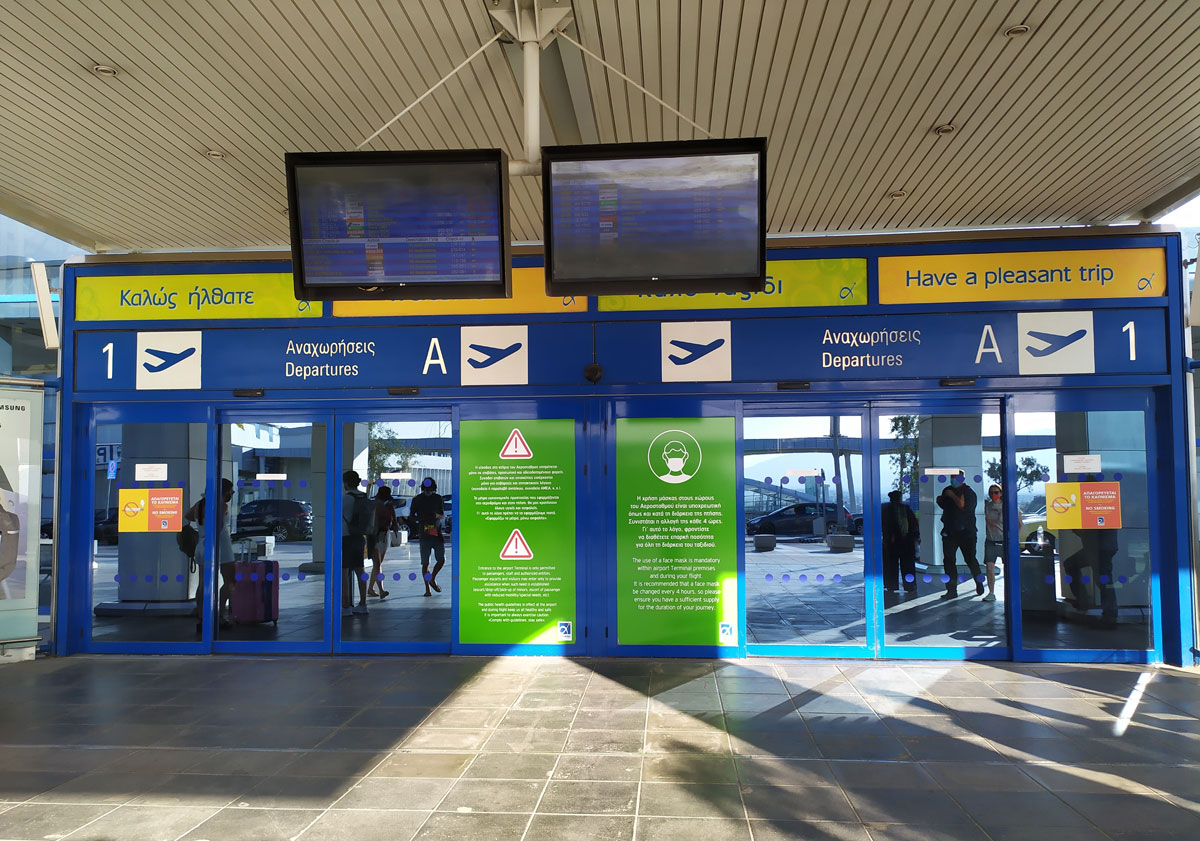
Photo Katerina Rozakou, August 2021
To quote this article: Rozaku, Katerina, "An Airport Ethnography of Voluntary Deportations, IOM Assisted Voluntary Returns From Greece", published on June 1st, 2022, antiAtlas #5 | 2022, online, URL : www.antiatlas-journal.net/05-rozakou-an-airport-ethnography-of-voluntary-deportations-iom-assisted-voluntary-returns-from-greece, last consultation on Date
Ι. Introduction
1. Immobilized on the way to the airport
1 A Friday in early 2016. I am supposed to be on my way to the Athens Eleftherios Venizelos International Airport to attend one of the IOM AVR (Assisted Voluntary Return) operations. Instead, I am stuck ten kilometers from the departures terminal and I do not expect to make it to A1 (first entrance to Area A to non-Schengen destinations) by one o’clock. This is the firm appointment between the IOM staff and the returnees who are travelling on this day.
As I sit immobilized in a 4 km traffic jam caused by the farmers' blocking of the motorway, I am listening on the radio about the demonstration outside the Greek parliament that is scheduled for the afternoon. The reporter informs the public that the protests concern the planned tax rises and pension reforms. Such reforms are part of the measures imposed by the most recent EU/IMF Economic Adjustment Program, one of the memoranda, as they are widely known, which have been imposed on Greek governments since 2010 when the country resorted to the IMF and the EU to deal with the debt crisis. The austerity of the last six years has led to the rapid impoverishment and violent decline of the middle classes, the growth of unemployment rates, changes in social status and the re-structuring of everyday life (Dalakoglou and Agelopoulos, 2018).
While I am trapped in my car, I realize that the returnees of that afternoon, people who have registered to the IOM AVR program, are probably in a similar situation. I imagine their exasperation and I think of them carrying oversized luggage with appliances, gifts and commodities collected after years of living and working in Greece, and the others who only carry a small backpack and are about to return after a few months in the country and an unsuccessful attempt to reach “Europe”; western and northern European countries. I picture their family and friends waiting at the airports of Casablanca, Dhaka, Kabul, Nairobi and Tehran or in the bus station of a small town. I am wondering about the booking arrangements that the IOM needs to make with Egypt Air, Qatar Airways, Emirates, Gulf Air and the other airline companies the organization cooperates with in implementing its AVR programs.
Waiting in the airport in vain
I am thinking of the detained returnees who take part in IOM AVR program who will have to return to the horrific Petrou Ralli preremoval detention center of Athens where they are only allowed one-hour yard time and no cell phones. I reflect on the little if any information they will be given on the reasons their return is being postponed. I can only imagine their uncertainty about what will happen next. Finally, I visualise the anger and the inconvenience of the police officers who escort these men, and the IOM airport team who will be waiting in the airport in vain.
I am aware of the fundamental temporal principles of airport and air travel mobilities. The rules are inflexible: anybody who does not make it to the appointment on time will not travel today. The strict adherence to the time schedule is an essential element of the airport modalities. In front of me the X95 Athens Airport Bus (transferring people from the center of Athens) also stands still. After half an hour of waiting, a few fearless passengers decide to exit the bus and walk the 10 kilometers to the airport dragging their suitcases behind them. I am wondering if any of them are returning “home” with the IOM on that day, but I detect none of the white plastic bags with the IOM logo.
next...
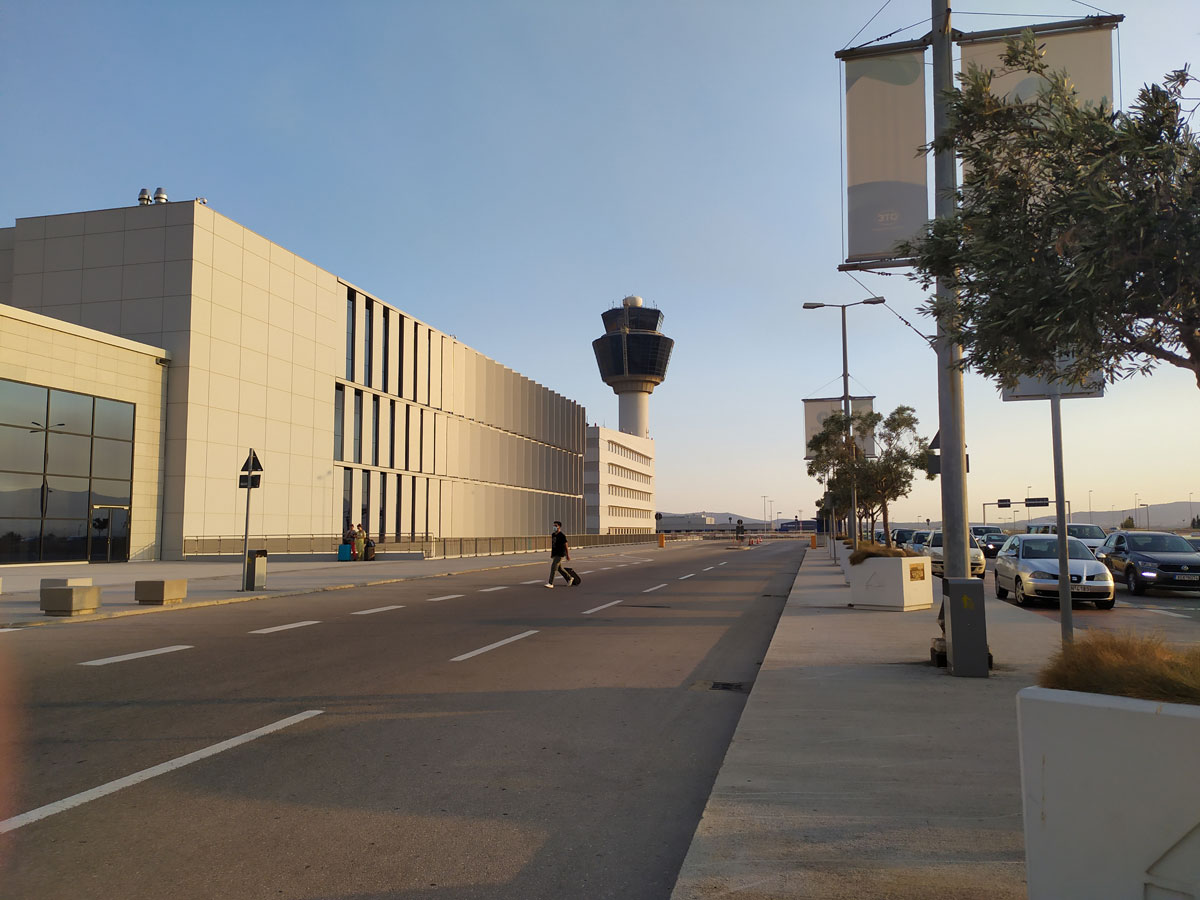
Athens Eleftherios Venizelos Airport, Giorgos Frigkas, August 2021
2. An airport ethnography of voluntary deportations
2 This article presents an anthropological study of deportations (Coutin 2015, Peutz 2006) through a phenomenological account of “voluntary” returns and, in particular, the AVR (Assisted Voluntary Return) program implemented by IOM (International Organization of Migration) Greece in collaboration with the Greek police. In line with recent critical studies (e.g., Kalir, 2017), IOM returns are here approached as “soft” or “voluntary” deportations whose allegedly free-will character depoliticizes expulsion and conceals their enforced essence under a mask of benevolence and humanitarianism. During my fieldwork, the airport kept appearing in the scene as more than merely the setting in these procedures and the final stage where illegalized migrants’ expulsion was implemented.
The airport is often thought of as a fluid and temporary place or a “non-place”, a term coined by Marc Augé (1995) in contrast to the anthropological place as a territorially and temporally bounded culture (Augé, 1995: 34). Non-places are non-relational, a-historical and identity-less transit points, such as hotels and refugee camps, holiday resorts and the airport, among other, that proliferate in supermodernity. As Augé puts it, “the space of non-place creates neither singular identity nor relations; only solitude, and similitude” (Augé, 1995: 103).
next...
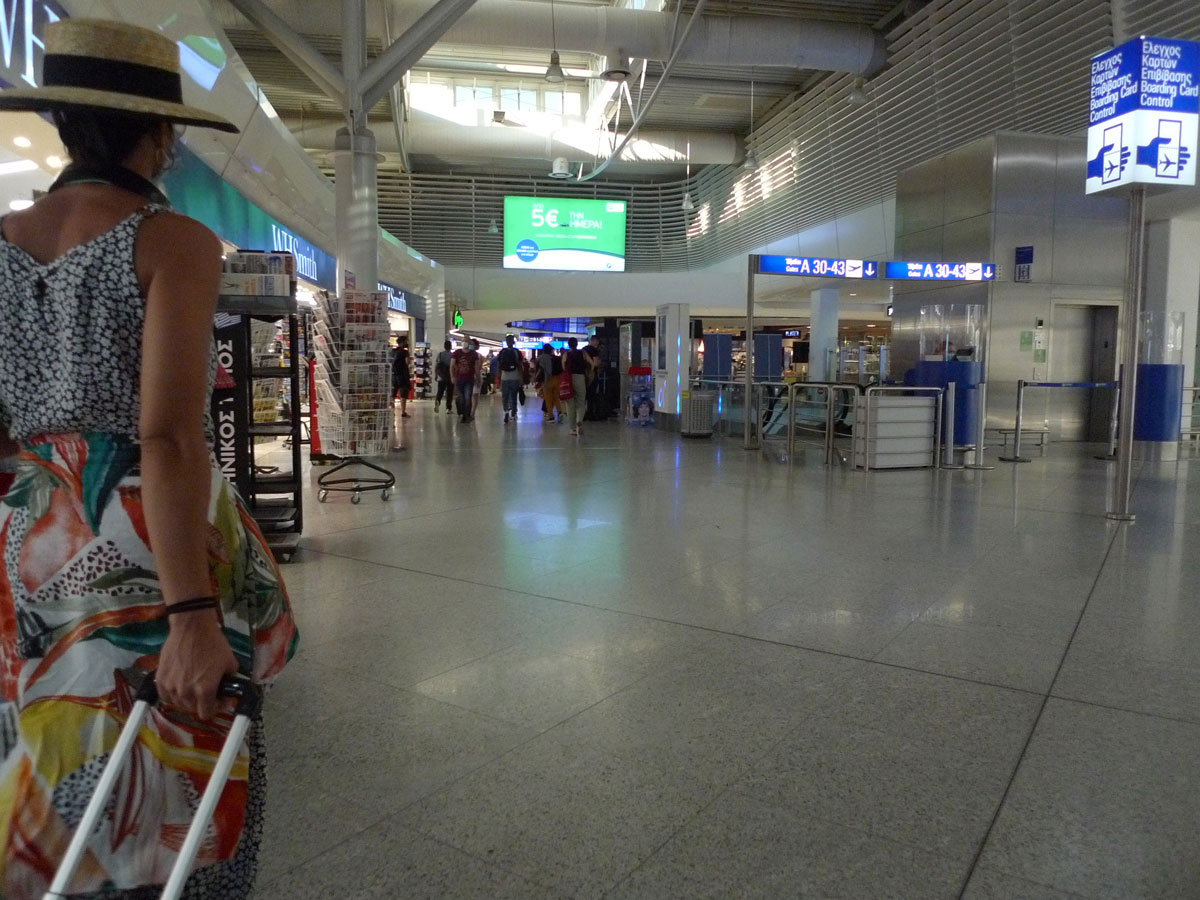
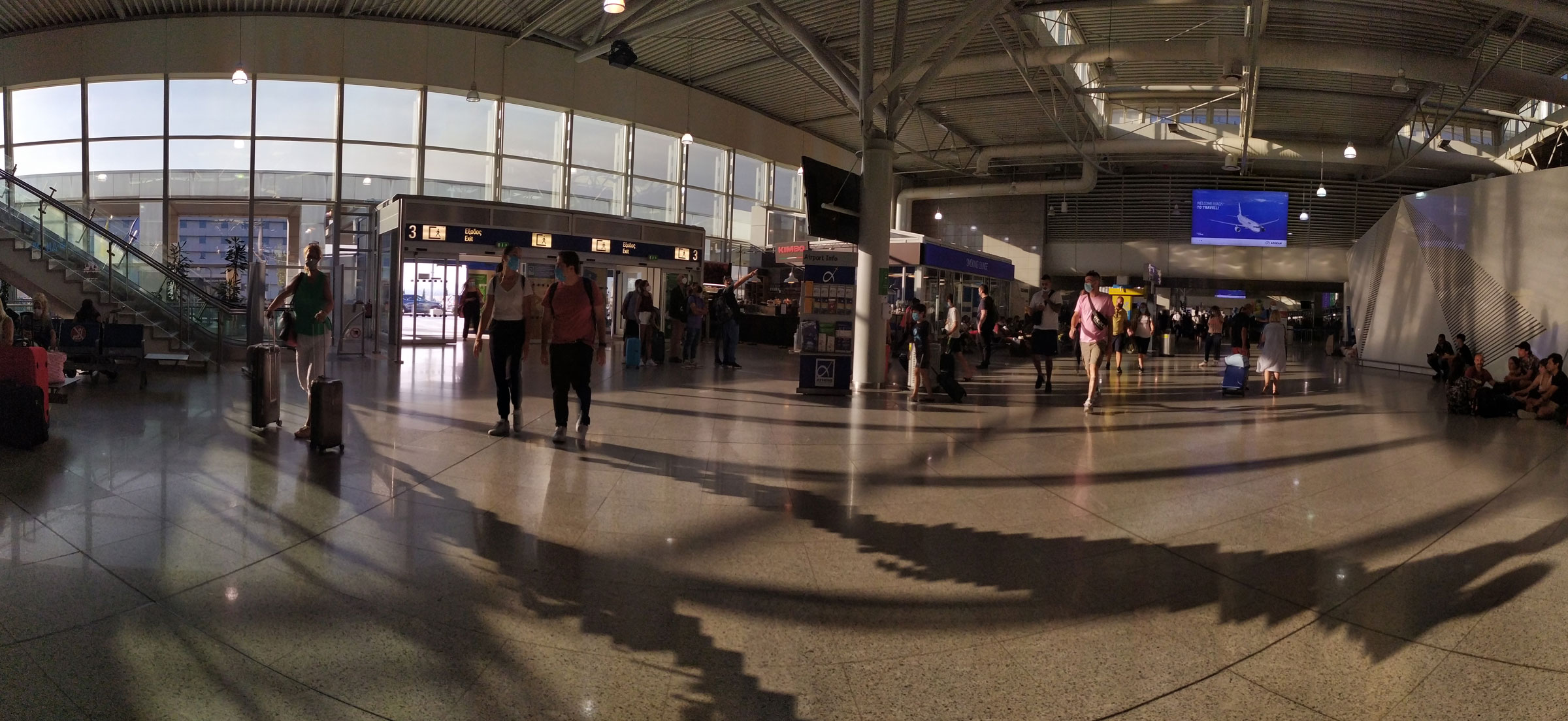
Airport Travelers. Photo Katerina Rozakou, August 2021
3 Augé’s traveler finds comfort in the familiar infrastructures and procedures of such non-places in airports all over the world. But the airport also hosts the trajectories of “banal” or “cosmopolitans de facto” (Agier, 2016), people, in the case examined in this article, who have defied borders but are ultimately “voluntarily” deported. For the privileged cosmopolitan traveler, the airport is a familiar place and unhindered and accelerated mobility is part of their symbolic capital and a signifier of “a surplus of rights” (Balibar, 2002, 83). For most of the IOM returnees, the air travel of their voluntary deportation is the first time they will travel by airplane. Most of them arrived at the country after perilous land and sea journeys. Numerous times their trajectories have been slowed down and accelerated beyond their control in moments of hastiness (Rozakou, 2020) and in the process of enforced – alas “voluntary” – return.
A space of differential and uneven mobilities
Despite its fluidity and transience as a temporary place of mobility, the airport cannot be thought of as a meaningless or relation-less space or a “non-place”. I here draw upon Doreen Massey’s critique to the binary distinction between space as abstract and meaningless and place as meaningful, lived, and quotidian. Following her theorization, I consider space as a constellation of different trajectories that is perpetually under construction (Massey, 2005). I thus approach the airport as a space of differential and uneven mobilities; both socially differentiated and unequally experienced (Massey 1993). The article also draws upon Brenda Chalfin’s (2008) concept of “airport sociality” that engages with the interplay between disparate actors and global and local forces at the airport.
next...
4 The airport is the border where diverse actors assemble, act, and cross each other: police officers, IOM employees, employees of private airline companies and the (private) management of the airport, as well as various other people who dwell and frequent it. How do state, intergovernmental and private sector agents interact, cooperate, compete and contest each other in the return process? What tensions derive from their coexistence? How do the thriving deportation business, the austerity crisis and a cosmopolitan aura cohabit in the Athens airport?
Countless trajectories that intersect
Massey conceptualizes space as constructed through and constructing the intertwining of diverse trajectories. She describes these chance encounters as a “throwntogetheness” that opens up spaces of negotiation and contestation and forms the relational politics of space (Massey, 2005). In the case of the airport examined here, this throwntogetherness is not limited to the apparent unequal mobilities of the privileged traveler and the unwanted “voluntarily” deported migrant but it includes countless trajectories that intersect: the random visitor to the airport, the airport handlers and the airline companies’ employees, the shop assistants of airport commercial shops, the lottery ticket vendor, the homeless people who arrive at dusk to find refuge during the night, and numerous other trajectories which coexist informing the multiplicity and simultaneity of space. I see these mobilities as embedded within power relations and persistent hierarchies while, at the same time, they challenge and negotiate them even at a locus of surveillance and control par excellence that is the airport (Adey, 2004).
The Athens Eleftherios Venizelos International Airport itself was inaugurated in March 2001 and was one of the infrastructural works completed in the broader area in preparation for the 2004 Athens Olympic Games. In the early 2000s Greece was a country under rapid change and optimism. Along with other infrastructural works, it is a reminder of the country’s era of economic growth and wealth in the early 2000s, a key emblem of the country’s achieved modernization (Gefou-Madianou, 2018). At the same time, the Athens airport is a product of the exploitation of illegalized migrant labor (Cheliotis, 2017), bringing to the fore the complex power-geometry of spatial politics (Massey, 2005).
The space of the airport is thus not only constructed in this multiple simultaneity of social relations but also beyond the present and the local, through a “simultaneity of stories-so-far” (Massey, 2005: 24). It is informed by the past era of economic growth in Greece and the ongoing austerity crisis. The space of the airport is made (quite literally) through the exploited labor of illegalized migrants who, in this article, are voluntarily returned during the austerity crisis but also through countless stories that comprise the Athens International airport as a culturally and historically specific space.
next...
3. Methodology
5 Between 2014-2016 I conducted research in registration, pre-removal and open reception centers for migrants, the Aliens’ Directorate of Attica and police stations, NGO premises, anti-detention and anti-deportation campaigns and solidarity initiatives. I had informal discussions and I conducted interviews with police officers, coast guards, NGO and IGO personnel, volunteers and activists. As part of my research on the IOM AVR program, I combined participant observation at the IOM’s premises, informal conversations and formal interviews with IOM employees. Finally, I also held discussions with migrants who participated in the IOM AVR programs and police officers who collaborated with the IOM during the implementation of return operations. The IOM AVR epofeloumenoi (“beneficiaries”, as they are officially named by the IOM following the dominant humanitarian vocabulary) were either migrants detained in pre-removal detention centers or non-detained migrants who were constantly escorted by IOM employees and police officers to their departure gate. To protect the anonymity of my research participants, certain elements regarding the specific period of the research and the profiles of my interlocutors have been altered.
Gaining access to the airport is extremely hard if one considers that apart from restrictions in access that researchers studying deportation more widely encounter (Maillet, Mountz and Williams, 2016), the airport is a highly securitized space (Adey 2004). This is probably one of the reasons that despite the impressive growth of the study of deportations since the 2000s (Drotbohm and Hasselberg, 2015), the infrastructures that facilitate deportations remain largely unseen. Eventually, I had the opportunity to attend more than ten ‘voluntary’ return operations that were carried out by the IOM staff and police officers and I had unhindered access to all stages of this procedure: from the airport terminals, to the final gates, the detention area where detained migrants were kept until they were “voluntarily” returned and the police vans that transferred detained returnees from pre-removal detention centers to the airport.
I was introduced to the airport’s parallel worlds
During my visits, I was introduced to the airport’s parallel worlds and their intersection with soft deportations. The IOM employees shared the airport’s secrets with me: the corners where homeless people found refuge, the extravagant rental cost of shopping space, the man who had been living in the airport for the last few months as he was unable to obtain travel documents to return to his country. Despite being a model candidate for the IOM AVR program, this man could not become its beneficiary. As the IOM employees explained to me, his case was hopeless as his country of origin—Pakistan—did not collaborate to the issuance of travel documents. The man was a non-citizen par excellence, rejected both by his country of origin and the Greek state.
next...
Chance encounters: throwntogetherness at the airport. Photo Katerina Rozakou, August 2021
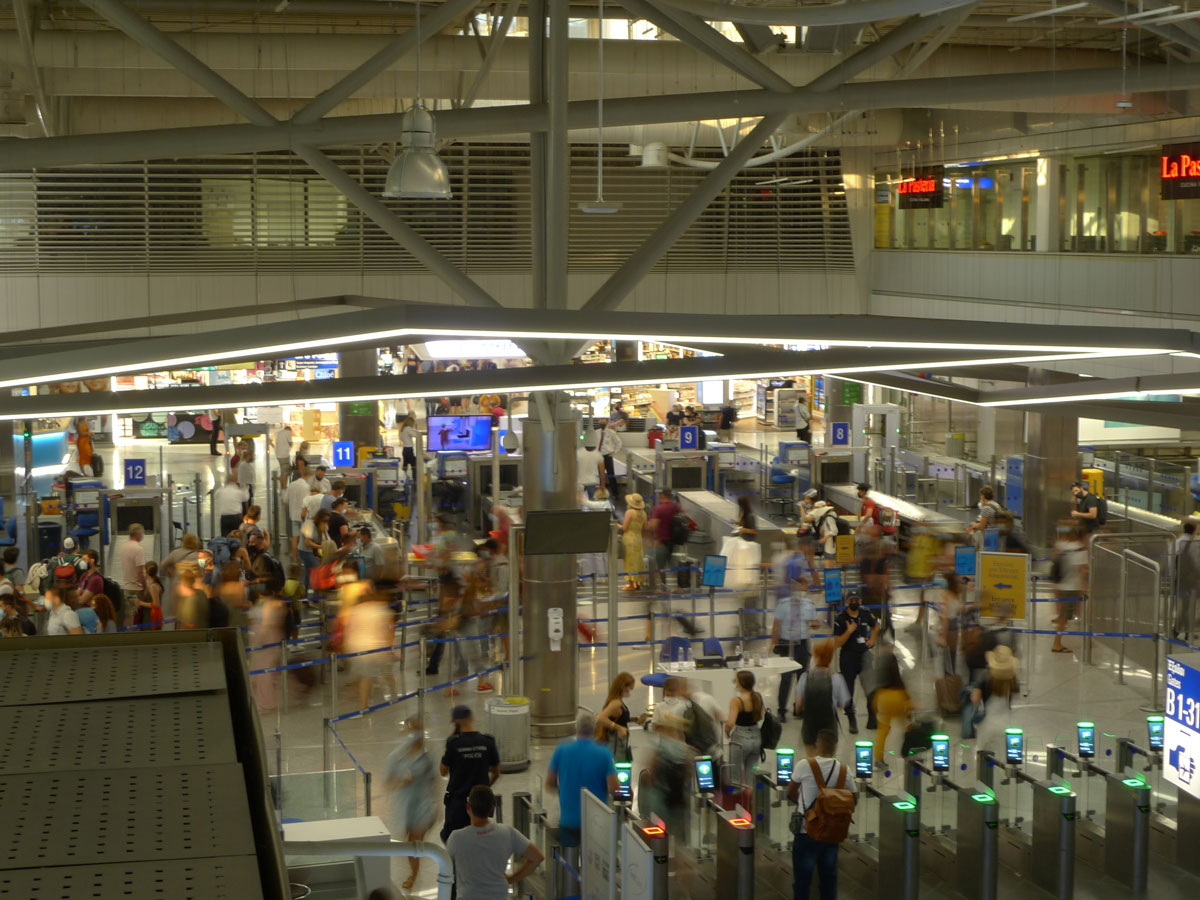
II. Humanitarian deportations
1. The IOM AVR program
6 “IOM remains convinced that, where feasible, AVRR is the most desirable form of return given that it takes the individual’s decision into account and allows returnees to prepare for their return while avoiding the stigma of deportation and its negative repercussions. It can also provide a viable and humanitarian response to migrants who are stranded and often destitute.”
(http://avrr.eg.iom.int/aboutus)
“Assisted voluntary return and reintegration (AVRR) is an indispensable part of a comprehensive approach to migration management aiming at orderly and humane return and reintegration of migrants who are unable or unwilling to remain in host or transit countries and wish to return voluntarily to their countries of origin” (IOM – Mission in Greece 2019: xviii).
next...
7 The Intergovernmental Committee for European Migration (ICEM) was founded in 1951 as an organization that aimed to regulate outward migration from Europe. In 1989 the organization was renamed the International Organization of Migration and had, by then, become a key agency in the field of “migration management” (Venturas, 2015). As an intergovernmental organization, IOM assists governments in their migration management plans. At the same time, as the opening excerpts indicate, the language of humanitarianism and human rights is central in IOM’s self-representation as well as a source of ethical legitimacy (Ashutosh and Mountz, 2011).
The IOM Office in Greece
The IOM Office in Greece operates according to the April 17, 1952 agreement between the Greek government and the organization. The Greek IOM office’s history and activities reflect the emigratory history of the country. For many years Greece was a country of outward migration and in the first decades of its operation (until the mid-1970s), IOM Greece (then ICEM) assisted over 140,000 Greek national emigrants settle in the USA, Canada, Australia, and other overseas countries. During the 1980s, the Greek office organized and implemented the resettlement of 89,000 foreign immigrants (from Eastern Europe, the Middle East and Africa) to the USA, Canada, Australia, and New Zealand.
It was only in 2010 that IOM Greece started implementing AVRR (Assisted Voluntary Return and Reintegration) programs in cooperation with the Greek authorities (mainly the police). Between 2010 and 2017 more than 35,000 beneficiaries participated in the IOM programs and returned to their countries of origin. In total, IOM Greece conducted more than 40,000 “voluntary returns” between 2012-2017.
next...
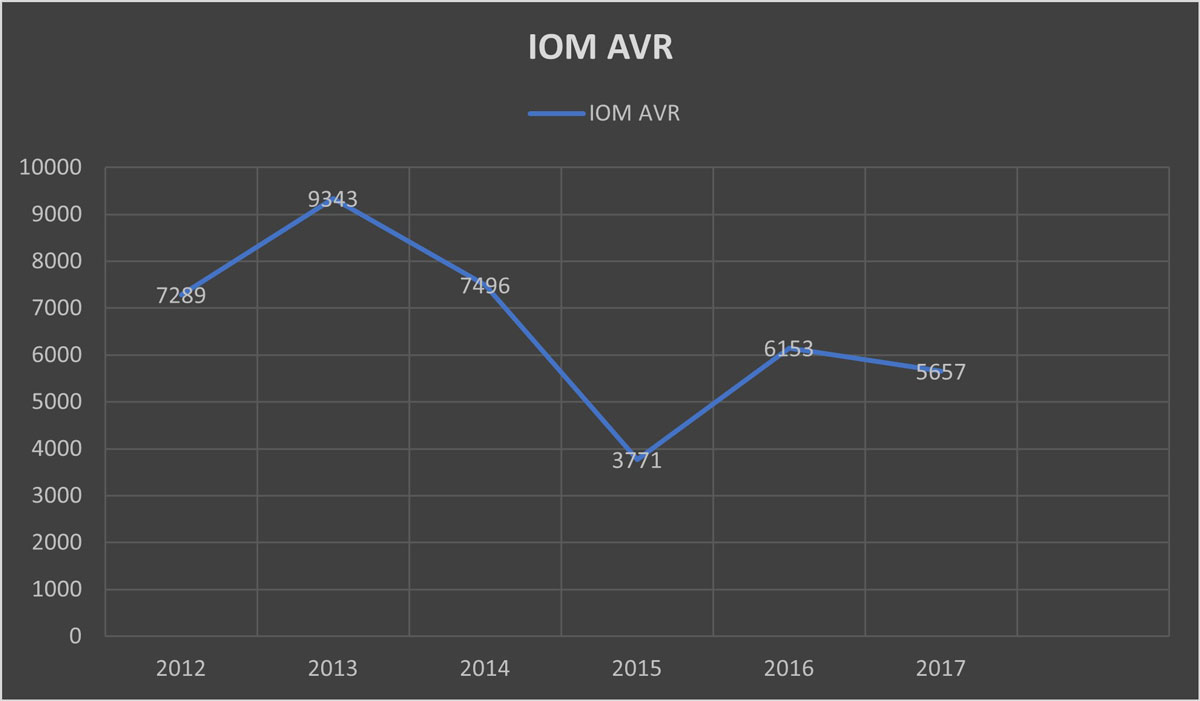
8 The IOM AVR projects were funded by the ERF (European Return Fund) and the Greek Ministry of Public Order and Citizen Protection (2010-2015)], the Government of the United Kingdom (2012 -2016), EEA Grants (Iceland, Lichtenstein, Norway) (February 2012- January 2013), the Swiss State Secretariat for Migration (December 2014-September 2015), the Norwegian Directorate of Immigration (July-September 2015) and AMIF (Asylum, Migration and Integration Fund) Emergency Funds (December 2015-May 2016) (IOM-Mission in Greece 2019). In many cases the IOM AVR programs followed quota on the nationalities of the returnees (as in UK government-funded programs, for instance). At other times specific nationalities were prioritized following directions from the Greek government.
The IOM AVR projects
The migrants who took part in the IOM AVR programs were provided with assistance during the return process, including travel arrangements, and the issuance of travel documents (in case they lack a passport, for example) and flight tickets. During the time of my research, each returnee received a monetary grant of 400 euros.
next...
2. Voluntary deportations
9 Despite being an important element of the “international government of borders” (Andrijasevic and Walters, 2010), the IOM remains empirically understudied (Pécoud, 2017). Although this paper is not a study of the IOM per se, it sheds light on the workings of the organization within the broader “deportation continuum” (Kalir and Wissink, 2016).
“Voluntary” returns only allegedly had a non-compulsory character
Contrary to the allegedly non-coercive character of “voluntary” returns, I am in line with recent scholarship that challenges the proclaimed open and non-compulsory elements and calls for a critical attentiveness to the violence that inhabits them. In recent years, studies highlight the complementary relationship between “voluntary” returns and deportations and the blurred boundaries between the two. Despite the IOM, the state and the EU emphasizing individual free-will (a concept with neo-liberal resonances), “voluntary” returns reflect structural violence.
“Voluntary” return is only a less evil “alternative to continued destitution” (Webber 2011: 103); a “pseudo-voluntary return”, “soft deportation” (Kalir 2017, Leerkes, van Os and Boersema, 2017) or “self-deportation” (Spathopoulou et al., 2020) for migrants who are in a condition of deportability (De Genova, 2002). Moreover, the language of voluntary returns may be one of benevolence that depoliticizes expulsion, but it is grounded in a humanitarian/security nexus (Bendixsen 2019, Vrăbiescu 2019) that eventually aims to expel unwanted migrants. State, non-state and international agents (such as intergovernmental organizations like the IOM) that collaborate in soft deportations form part of a “deportation continuum” (Kalir and Wissink, 2016) operating through “functional complementarities” (Koch, 2014).
The non-voluntary element in “voluntary deportations” is particularly evident in the case of Greece where detention has been the dominant approach to illegalized migration, at least until 2015. Consent to return through the IOM AVR programs can barely be considered a choice since it is accomplished under the pressure of prolonged and punitive detention. Particularly between 2012-2015, but not limited to this period, Greek migration policies were grounded in the prevalent use of pre-removal administrative detention of illegalized migrants and asylum seekers as a deterrence and punitive measure, rather than merely as an effective practice towards returns. The practice has been criticized as insufficient in promoting effective returns, costly (Angeli, Dimitriadi and Triandafyllidou, 2014) and in violation of human rights (European Committee for the Prevention of Torture and Inhuman or Degrading Treatment or Punishment – CPT 2017). Until 2015, the Greek state broadly implemented the legal maximum of 18 months of detention, and in March 2014 the State Legal Council endorsed the legality of “indefinite detention” beyond that period (State Legal Council Opinion 44/2014). “Voluntary” deportation was, in fact, often the only feasible way out of pre-removal detention for illegalized migrants.
The detained returnees had usually no control over the procedure. They were not even informed by the police officers about their transfer to the airport until the very day of their flight. Sometimes it was only when they had already arrived at the airport terminal that they realized they were about to return as the police officers shared no information when they boarded them on the bus. There were instances when detainees had refused to board the bus, not knowing where they were being taken.
next...
3. “Apelasi” (“deportation” in Greek)
10 In January 2015, the national elections led to a political shift with a new coalition government formed by the left-wing political party of SYRIZA and the small right-wing party ANEL. The newly elected government announced the closure of detention facilities and the end of the restrictive and punitive policies that were implemented by the previous governments. Although none of the detention facilities eventually closed, after spring 2015, the detention period was reduced to six months and asylum applicants and vulnerable detainees were released.
The year 2015 is known as the year of the “European migration/ refugee crisis” with Greece as its epicenter as more than 800,000 border crossers in need of shelter and protection arrived at Greece through the Eastern Mediterranean route. Even though that time is considered one of relatively unhindered cross-border mobility towards northern and western Europe, this was also a period where soft deportations from Greece were conducted. Deportations had halted in 2014 due to the cost of the operations and the toll on a crisis-ridden Greek economy, but only temporarily to commence again after the summer of 2015. However, what had changed was the profile of the people “deported softly”.
Soft deportations were conducted, even during the “migration/refugee crisis”
In 2015 and 2016, most of the people who registered and participated in the IOM AVR programs had only recently arrived in Greece. These (mostly) men considered Greece a transit country and when they realized that they could no longer carry on their journey to Western and Northern Europe, they decided to return. However, at the same time, the illegalization of specific nationalities was reflected in the profiles of the detained returnees. Thus, men of Moroccan origin were massively detained and finally returned with the IOM AVR programs during that period.
To promote participation to the IOM AVR program, the Greek government introduced a special detention area for IOM beneficiaries in the pre-removal detention center of the Moria camp on the island of Lesvos in 2017. In my visit there in September 2017, I was informed by the police officers in charge that one of the two sections of the detention center contained people who were registered to the IOM AVR program and who remained detained until their transfer to Athens where their travel documents would be issued, and their voluntary deportation completed. This seemingly paradoxical detention of people who had signed up for their return in free will further underscores the compulsory character of soft deportations.
next...
11 Moreover, during my research I often came across the blurring of categories and an emic vocabulary around “voluntary” returns that most emphatically echoes the forced character of a presumably non-coercive return practice. The shift in terminology around deportations at the EU level demonstrates the effort to conceal and depoliticize the violence of state practices of expulsion of illegalized migrants.
As historian Rika Benveniste notes for the deportation of Greek Jews to Nazi concentration camps, the language of bureaucracy “always conceals, either with euphemisms or with sterilized, neutral words (…) [it] seeks to mislead and deter thinking” (Benveniste, 2017: 85). In the last years and after adopting the official vocabulary of EU legislation regarding deportations (EU Return Directive 2008), the Greek Ministry of Citizen’s Protection replaced the term “deportation” with “return”. The former “Deportations Department” in the Aliens’ Directorate of Attica altered its title and in official announcements it used the neutral and depoliticized term “return”, though not consistently. In fact, police officers mocked this shift in vocabulary and scrutinized it as hypocritical.
The language of bureaucracy depoliticizes and conceals the violence of deportations
However, it is important to note that, as far as deportations are concerned, the Greek term apelasi (deportation) does not hold the same historical weight as in other contexts where deportations are directly associated with the historical experience and the atrocities of the Holocaust. Thus, the Greek Jews who were forcibly removed and sent to extermination camps during WWII were widely referred to as omiroi (hostages) in the language of Greek bureaucracy (Benveniste, 2017) and not as deportees.
“Deport” was the way migrants themselves referred to the process of “voluntary” return, underlining the blurred boundaries between coercion and choice. The only differences between “voluntary” return and “deportation” were the monetary grant and the fact that migrants enlisted in the IOM AVR programs were not registered in the list of unwanted third-country nationals.
next...
III. Airport encounters
1. Air travelers
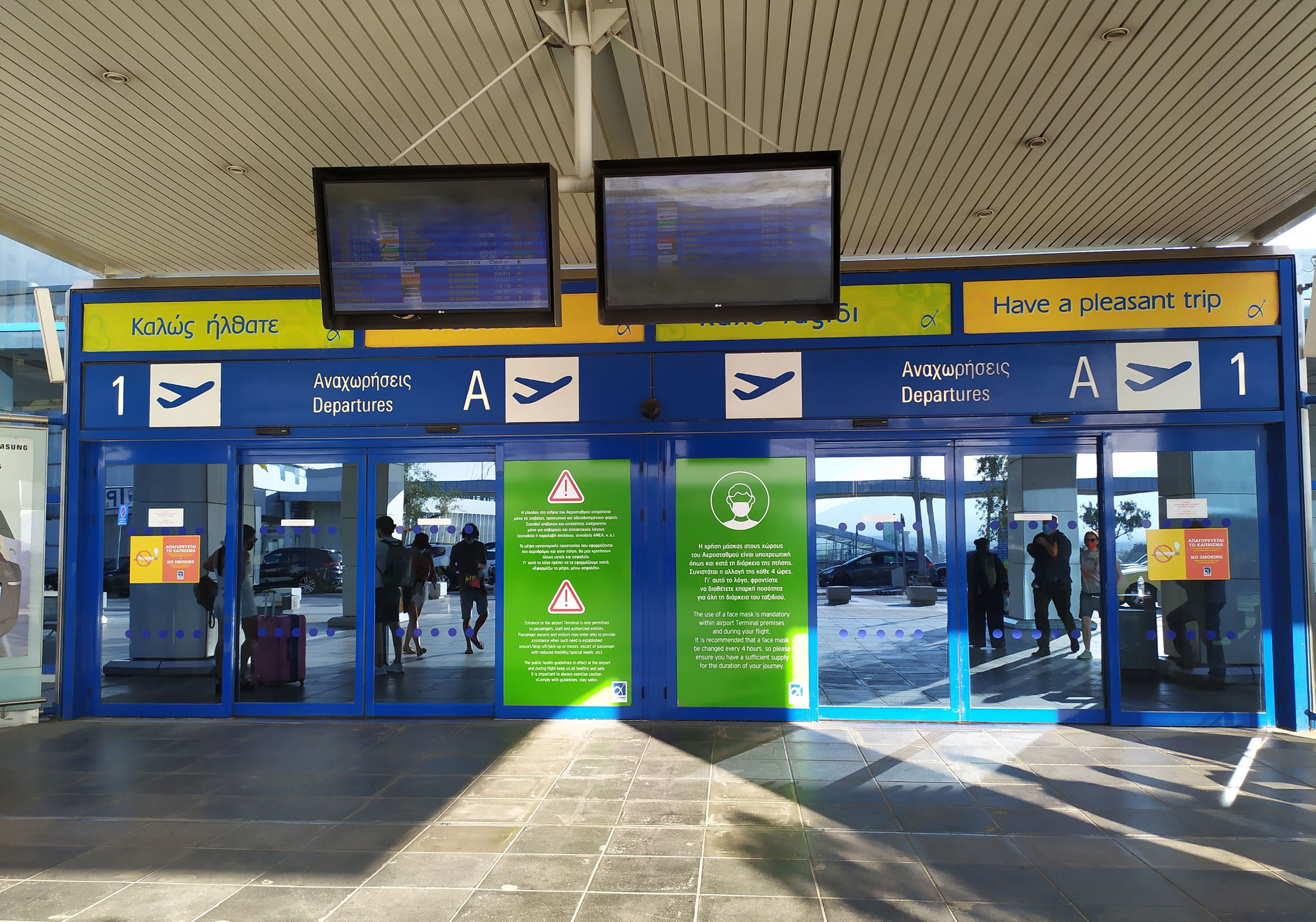
Photo Katerina Rozakou, August 2021
12 The IOM airport team commutes to the airport by a civilian car that the Police has allotted to the organization. The worn-out vehicle is in pressing need of repair as it coughs constantly on the way to the airport. However, at least four times a week, the car manages to cover the forty kilometers distance between the IOM premises and the Athens International Airport where it parks outside the departure terminal in a designated area for police vehicles. Georgia and Dimitris head to a fixed appointment at the A1 entrance where they meet a group of fifteen people, mostly men, from Bangladesh, Egypt, Ghana, India, Kenya, Morocco, and Nigeria. Luggage is scattered everywhere.
The two IOM employees call out names and distribute laissez-passer travel documents. Georgia, who has been working in this post for several years, is firm while giving directions. Talking in English, she tells the group to use their IOM plastic bags to secure the four precious documents: their travel document (either the laissez-passer document the IOM employees brought on that day or the passport the returnees already hold), their harti (the administrative expulsion order that was issued by the police and which dictates that the holder must leave the country voluntarily within a period of one month), the declaration (of participation in the IOM AVR program) and the print-out of their flight details. Georgia stresses that they must carry their IOM bag all the time. This white plastic bag with the IOM emblem is not merely practical to carry these travelers’ important documents. It is also the marker that IOM employees use to visually trace the returnees in the airport. At the same time, this mundane object contradicts the luxury of the airport, the manifested and often celebrated individuality of the air traveler.
They occupy the back seats of the airplanes and travel with one-way tickets
Georgia goes on to instruct the group to always follow her and Dimitris. The IOM beneficiaries are not allowed to take any photos, exchange currency in the airport exchange offices or buy any goods from the airport’s Duty-Free shops. They cannot use the designated smoking areas of the airport. Although the pretext is that any delay will cause the entire group to be late and may jeopardize their return, these prohibitions signify the fact that the airport facilities are not designated for them.
Even though these people travel on the same commercial flights as other travelers, they seem to belong to a different category of travelers; ones who are excluded from this world of enhanced mobility and of luxurious consumption that the airport exemplifies. They are the passengers who occupy the back seats of the airplanes and the ones who travel with one-way tickets. The gathered group presents a cacophony in contrast with the individuality of the air travelers who move with a rapid pace and confidence around us and only fleetingly slow down to observe the scene. And yet, these voluntary deportations do not occur in secrecy. Quite the contrary, they are performed out in the open, attracting the eyes of fellow travelers and, at times, the discontent of airline companies and airport personnel.
next...
2. Encounters of uneven voluntary deportations
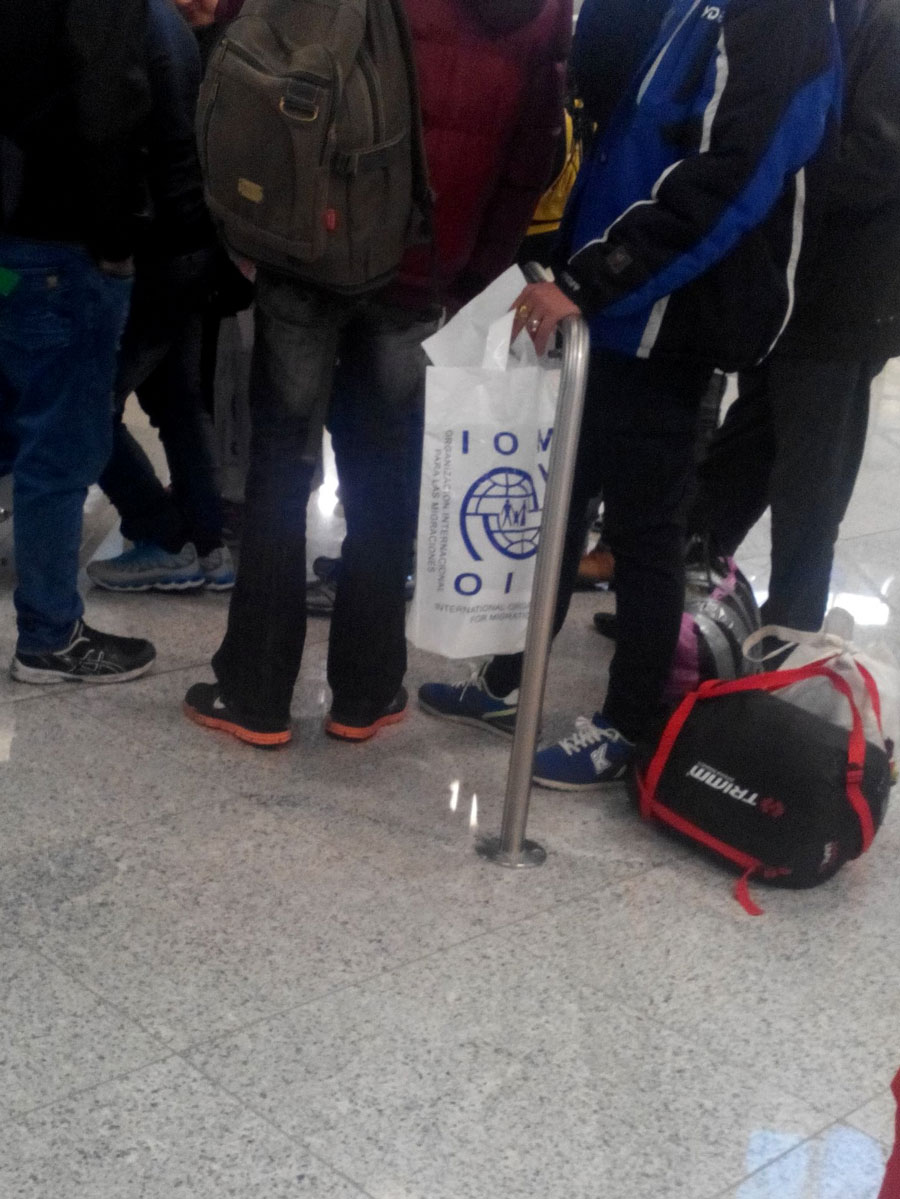
Voluntary deportations luggage: the IOM plastic bag. Photo Katerina Rozakou, August 2021
13 The airport is a space of uneven mobilities that concerns the acute contrast between the privileged multidirectional mobilities of air travellers (both through the airport and in it) and the one-way travel, the “voluntary” return of IOM returnees. However, even the IOM returnees are not all partaking in the same mobility.
The blurring of the differences between return and deportation, became clear to me during my fieldwork when, at the passport control checkpoint, a group of 10-12 Iranian men escorted by the IOM employees encountered a group of Moroccan men escorted by police officers. The most experienced IOM staff informally called the detained returnees “dets” (an abbreviation of “detainees”). Most of the Moroccan “dets” had no luggage, and some held nothing but the plastic IOM bag. Some of them wore no shoelaces and looked exhausted and surrendered. During the time between check-in and passport control, these detainees were placed in a small room by the passport control area entrance to non-Schengen destinations. The police officers guarded the small room, which was often crowded and lacked enough seats forcing several men to stand.
Deport! Deport!
Deport! Deport! When the two groups of returnees ran across each other, the Iranian men told me that the other group were “deport”. Although I explained to them that they were also returning voluntarily with the same IOM program, the men were not convinced. “Will they get money too?” they asked, receiving my positive answer. When I discussed the incident with Dafne, one of the older IOM employees, she explained to me that this confusion was far from a novelty. Every time she visited pre-removal detention centers in the past, detainees cried out (we want to) “Deport! Deport!” when they saw her wearing the blue IOM vest. Even later, when they were more familiar with her, they still called out “deport”.
next...
14 Both groups (the detained Moroccan men and the free Iranian returnees) were travelling on that day with the IOM AVR program. The Moroccan men were escorted by police officers wearing civilian clothing and they were going through the same procedures as the men from Iran who were also constantly escorted by IOM employees. According to the procedure, it was only after passport control that all IOM AVR beneficiaries received a cash-grant of 400 euros.
Georgia, the IOM employee who had the responsibility of handing the men their envelope with the money, was a veteran. Sitting next to the police officer inside the passport checkpoint, she carefully counted the banknotes before putting them in a white envelope. The returnee had to sign an affidavit that he/she received the cash-grant. Georgia explained to me that the technicalities and the formality of the procedures were of utmost importance since in the past a returnee accused an IOM employee of not giving them the cash-grant. The constant presence of the airport police officer (in uniform) sealed the official character of the procedure and stressed the repercussions of misconduct.
A moment of increased excitement and advanced precaution
This was always a moment of increased excitement and advanced precaution. The police officers and the IOM staff alike emphasized that the returnees should not display the cash they received openly, nor cheer or take any photos. Their directions were not always followed, however. Some men counted the notes openly and provocatively and then teased their compatriots, waving the envelope or the notes over their head. The police officers who were looking forward to the end of the procedure would then get angry and frustrated. They would approach and threaten the IOM beneficiaries that their cash-grant would be taken back, and their return cancelled. In fact, the police officers considered the 400 euro return cash-grant as a “bribe” and as the main motive that prompted people to sign up for the IOM AVR program.
Such moments provoked excitement to the other migrants and curiosity to travelers who slowed down their pace to observe the scene. Their gaze moved from the IOM employees in blue vests with the organization’s emblem to the police officers who, despite wearing civilian clothing, were swiftly identified. Instances like these were moments of negotiation that challenged the airport as a space of ordered fluidity and strict temporalities. There were moments when the soon-to-be expulled migrants claimed space and made their presence visible and audible.
next...
3. Travel agents of removal
15 Ruben Andersson (2014) has introduced the term “illegal migration industry” to refer to the productive character of attempts to control human mobility. This illegality industry comprises various sectors engaged in controlling land and sea migration into Europe but also a vast array of institutions, enterprises and people. As part of this broader illegality industry, the deportation industry nourishes not only the migration management sector—state, non-state, supra-state and inter-state—but also the private sector, such as airline companies that travel fully booked to the destinations of deportable aliens.
As part of the deportation industry, the IOM employees were travel agents of removal
As part of this deportation industry, the police officers, the employees of airline companies and the airport and, also, the IOM employees were, in a way, travel agents of removal. In the early days of my research, I realized that the people who conducted the IOM AVR operations at the airport had no previous experience in the humanitarian sector or migration management. Instead, almost all of them previously used to work for airline companies or travel agencies.
Maria, who recently became part of the IOM airport team, is an old acquaintance of Georgia. Both used to work for Olympic Airways, the legendary national airline that was created by shipping magnate Aristotle Onassis in 1957 and sold to the Greek state in 1975. In 2009, however, after a decade of financial losses and debts and the enforcement of EU liberalizing competition rules by the European Commission that prohibited state aids to the national airline, Olympic Airways was sold by the Greek state and became a private airline company, eventually merged with Aegean Airlines. Both Maria and Georgia cherished their time working for Olympic Airways and recalled it with nostalgia. As we were during work at the airport, Georgia showed us the keychain with the emblematic six ring Olympic logo that she still used and explained that this attachment with Olympiaki (the “Olympic”), as it is widely known in Greece and affectively called by its former employees, went beyond lavish working conditions. Her attachment resonated with a cosmopolitan and prestigious profession but also with the materialization of stateness that national airlines denote in general (Bryant, 2021). Furthermore, the golden age of Olympic Airways corresponds with the post-war era of economic growth in Greece, whereas its collapse foretells the Greek debt and austerity crisis.
Georgia and Maria shared stories about the collegiality and the intimacy among co-workers who still greeted each other enthusiastically when they met in the new Athens airport where they are employed as airport personnel or by airline companies. Maria then reflected on the worsening working conditions that followed the dismantling of Olympic Airlines, the gradual prevalence of precarity, temporary contracts and degrading salaries.
next...
16 Especially the austerity crisis of recent years in Greece has turned jobs in airline companies and at the airport into underpaid and precarious ones. Airline companies have used the crisis as an opportunity to cut down on wages and to impose individual work contracts with limited labor rights. In some cases, as the IOM employees explained to me, people in that sector received a monthly salary of less than 380 euros and were obliged to sign short-term contracts with uncertain renewal. The airport personnel constantly change, and the airline companies consider them temporary and disposable. What used to be perceived as a lavish profession has turned into a precarious one that retains little of the glamour of a cosmopolitan environment. Fifty-year old Christos, who was also newly employed in the IOM airport team, elaborated on this insight. He also explained to me that it was by far more profitable to work for the IOM and receive a salary three times more than the one “handlers” (airport personnel) usually took.
A blossoming deportation industry
The IOM airport employees felt the airport to be their second home and they moved around greeting people from airline companies, police officers and airport personnel. Every time, upon arriving to work at the airport, they visited the airport police office to receive a pass that enabled their unhindered mobility in areas that were designated for air travelers only. The IOM airport employees shared secrets about Duty-Free goods and discounts on snacks and coffee for airport personnel. However, at times they were uncomfortable. This was especially noticeable in the newly employed ones who were just beginning to make sense of their new role. Instead of working in an industry of privileged traveling, they were now part of a blossoming deportation industry. They felt uneasy as they thought that their presence was unfitting in a place of order and luxury such as the airport.
This world of uneven mobilities is guided by the rules of a neoliberal market. In the airport the authority of an airline employee could at times be greater than that of the IOM or the police. Even the state had to obey the rules of the free market in this zone of conflicting sovereignties. The Egypt Air supervisor was the dreadful Ahmed who, as Georgia explained to me, was notorious in the airport for his strictness and ability to extract extra luggage payments from passengers who did not abide with the flight regulations. Ahmed stood by the departure gate and exhibited his authority to passengers who carried oversized hand-luggage. Many times, Georgia had to negotiate with Ahmed when IOM returnees were forced to pay for any extra carry-on bags, but she did not always succeed and at times they had to pay with part of their return cash-grant to take their luggage on the plane. Georgia considered Ahmed’s attitude to be an extreme manifestation of power and unethical as it was exercised on deprived migrants, yet there was nothing she could do.
next...
The airport. Video, Katerina Rozakou, August 2021.
4. Disruptions
17 When the number of IOM returnees increased significantly in early 2016, the police officers suggested that detained returnees should not go through the individual check-in procedure like the rest of the passengers, including the “free” migrants registered to the IOM AVR program. Instead, they suggested the travel documents and tickets of the detained returnees were handed in the check-in counter by IOM employees and police officers. As the IOM employees explained to me, the police officers were mostly worried that a detained returnee would flee amid overcrowded returns and lengthy procedures. Yet, an additional reason might be the last-minute hesitation of a detained returnee and their withdrawal from the IOM AVR program. In a couple of such cases that I witnessed, the police officers put a lot of effort in trying to change the men’s decision by explaining that by cancelling their return they would return to infinite detention and, moreover, they would not be able to join the IOM AVR program again. In any case, the police officers’ suggestion was deemed out of the question since airline companies demanded to see all passengers in person.
The airport’s life could not be disturbed
To address the problem, the police officers suggested an alternative procedure; however, this was implemented only once due to the reactions of airline companies. After the check-in, detained returnees were driven by a police vehicle to the Satellite building of the airport. Dimitris explained to me that the building was constructed during the Athens 2004 Olympic Games and is only accessible through the airplane runway. Considering the fact that this was the place where deportations were normally handled, one cannot but conclude that even “voluntary” returns were severely criminalized and that they are non-coercive in name only. Yet, at least at the time of my research, the Satellite building was not used again for IOM AVR returnees. The airport’s life could not be further disturbed yet it was constantly negotiated and challenged through the co-existence of these diverse and uneven mobilities.
It was not merely the airport ethos that made the IOM employees uncomfortable with their task of escorting unwanted travelers. Rather, the management of the airport itself had requested a “discreet” presence and the placement of the beneficiaries in the far end corners of the departure gates. Other passengers were visibly taken aback by the men who lined up and obstructed the well-orchestrated flow of travelers: in the check-in desks of airport companies, in the passport and visa control check points, in the hand-luggage check points, and finally at the gate before the airplane embarkation. Nevertheless, these returns did not occur in secrecy. Quite the contrary, they were performed out in the open, attracting the eyes of fellow travelers and the discontent of airline companies and airport personnel.
next...
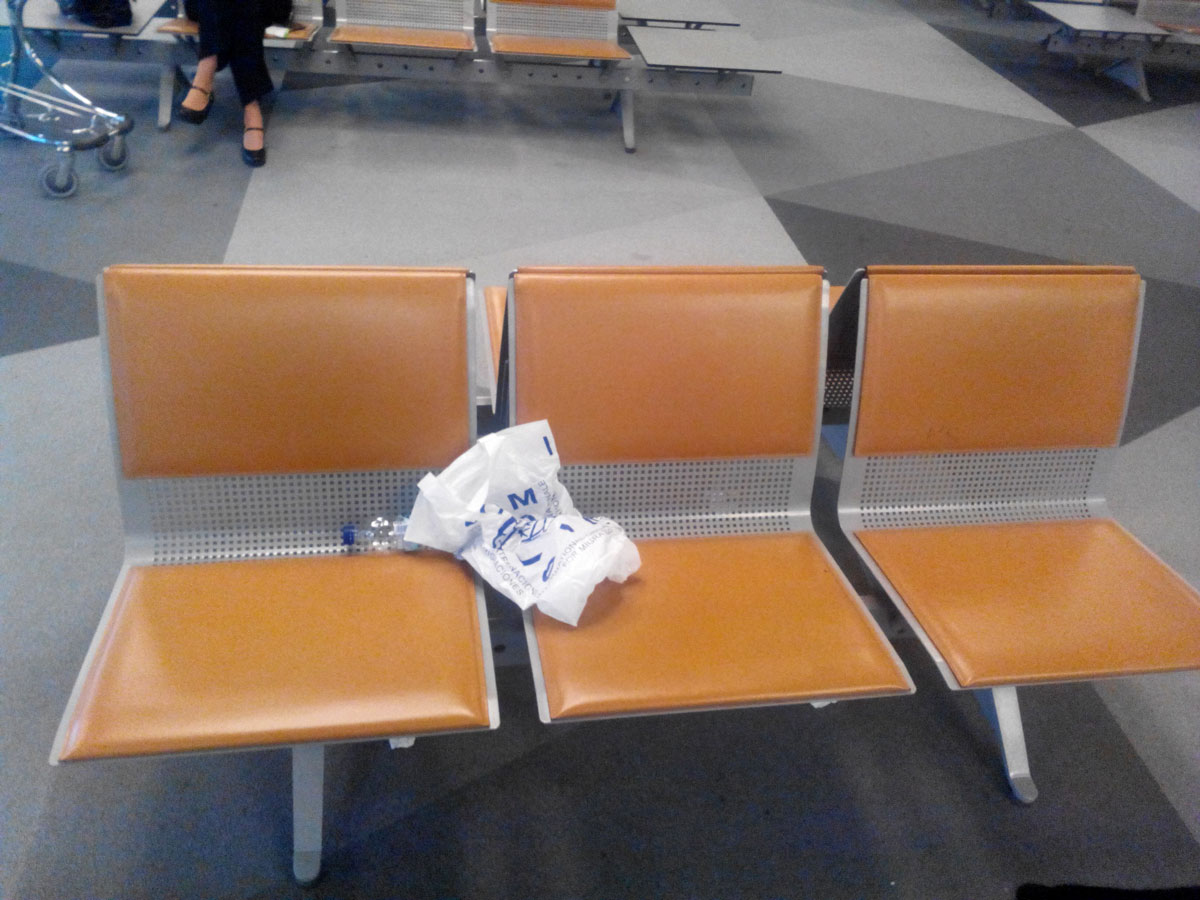
Voluntary deportations remains. Photo, Katerina Rozakou, August 2021
IV. Conclusion : a space of intersecting and uneven trajectories and stories-so-far
18 The artificial bright lights of the airport, the impeccable cleanliness of the floor and the touristic and commercial posters embellished with the bright smiles of travelers are endemic to the airport as a site of cosmopolitanism and luxury. However, in this age of globalized circulation of goods, airport merchandise retains only a small part of its past glory and exclusiveness. Nowadays Toblerone chocolate bars, expensive liquor and cigars are no longer precious goods that are given as souvenirs of privileged cross-border mobility and brand-named stores; instead, they are found everywhere (even in austerity-ridden places of the world).
Moreover, air travel has long stopped being the privilege of the wealthy. With the expansion of low-cost mobility more people have been travelling by airplanes and at the same time, air travel has become more socially stratified. Work in the airport and in airline companies has lost its prestige and lavishness and it has become precarious and underpaid. Nevertheless, the airport of Athens still possesses its postmodern and cosmopolitan aura. The Duty-Free section respires tested perfumes and the soft background music adds to the affective experience of privileged mobility.
The space of the Athens International airport is constructed out of the differential mobilities and the uneven trajectories of its diverse “inhabitants”: privileged cosmopolitan travellers for whom the crossing of the border is a formality “passed at a jog-trot” (Balibar, 2002: 83) and others traveling on low-cost air tickets, crisis-stricken and precarious airport and airline companies’ personnel, flight attendants and pilots striding across the airport corridors with confidence, police officers on duty lazily escorting detained returnees, shop assistants serving customers in airport shops with extravagant rents, homeless people who find refuge at the airport at night, the lottery ticket vendor selling his goods, the stranded Pakistani man, unclaimed by his state, the IOM employees moving swiftly and efficiently, the unwanted and voluntarily deported migrant travelling in the back seats of the airplane and numerous others that are not presented in this article, such as locals of the Mesogia region for whom the airport is a space of sociality (Gefou-Madianou, 2018) and many others.
The airport is also a space constructed by the stories-so-far
The airport is also a space constructed by the stories-so-far (Massey 2005), ranging from the irregular migrant labour that built it, the austerity crisis that has formed the labour and living conditions of its contemporary employees, the legendary national airline Olympic Airlines that was dismantled signifying not only the degradation of its former employees but also a crisis in stateness and sovereignty.
The unwanted and soon-to-be removed alien is an anomaly in relation to the cosmopolitan and luxurious face of the Athens airport. Their ambiguous presence in the airport brings to the fore diverse imaginings of exclusion and mobility. The gazes of curious travelers, the ambivalence of the airport authorities, the insecurity of the police officers and the ambivalence of the IOM employees, the jokes and provocations of voluntarily deported migrants, all demonstrate that the airport is not a fixed space but one under constant negotiation and contestation.
next...
References
19
Agier Michel, 2016, Borderlands : towards an anthropology of the cosmopolitan condition, transl. by David Fernbach, Cambridge, Polity.
Andersson Ruben, 2014, Illegality inc. : clandestine migration and the business of bordering Europe, Oakland, University of California Press.
Adey Peter, 2004, “Surveillance at the airport : surveillance mobility/mobilising surveillance”, Environment and Planning A 36 : 1365-1380.
Andrijasevic Rutvica and Walters William, 2010, “The International Organization for Migration and the international government of borders”, Environment and Planning D: Society and Space 28 : 977-999.
Angeli Danai, Dimitriadi Angeliki and Triandafyllidou Anna, 2014, “Assessing the cost-effectiveness of irregular migration control policies in Greece. MIDAS (Migration and Detention Assessment) policy paper”, Hellenic Foundation for European and Foreign Policy (ELIAMEP) [Online] | October 2014, accessed 6 December 2021.
URL : http://www.eliamep.gr/wp-content/uploads/2014/11/MIDAS-Policy-Paper-EN.pdf
Ashutosh Ishan and Mountz Alison, 2011, “Migration management for the benefit of whom? Interrogating the work of the International Organization for Migration”, Citizenship Studies 15 : 21-38.
Augé Marc, 1995, Non-places : an introduction to supermodernity, London, Verso.
Balibar Étienne, 2002, “What is a border?”, in Politics and the Other Scene, London, Verso.
Bendixsen Synnøve, 2019, “The care/security nexus of the humanitarian border : assisted return in Norway”, International Migration 58 : 108-122.
Benveniste Rika, 2017, Luna : an essay in historical biography, Athens, Polis (in Greek).
Bryant Rebecca, 2021, “Sovereignty in the skies : an anthropology of everyday aeropolitics”, in Bryant, Rebecca and Madeleine Reeves (eds), The everyday lives of sovereignty : political imagination beyond the state, Ithaca, Cornell University Press.
Chalfin Brenda, 2008, “Sovereigns and citizens in close encounter : airport anthropology and customs regimes in neoliberal Ghana”, American Ethnologist 35 : 519-538.
Cheliotis Leonidas K., 2017, “Punitive inclusion : the political economy of irregular migration in the margins of Europe”, European Journal of Criminology 14 : 78-99.
Coutin Susan B., 2015, “Deportation studies : origins, themes and directions”, Journal of Ethnic and Migration Studies 41 : 671-681.
Dalakoglou Dimitris and Agelopoulos Georgios (eds.), 2018, Critical times in Greece : anthropological engagements with the crisis, London, Routledge.
De Genova Nicholas, 2002, “Migrant ‘illegality’ and deportability in everyday life”, Annual Review of Anthropology 31 : 419-447.
Drotbohm Heike and Hasselberg Ines, 2015, “Deportation, anxiety, justice : new ethnographic perspectives”, Journal of Ethnic and Migration Studies 41 : 551-562.
Gefou-Madianou Dimitra, 2018, “Messogia, the new ‘Eleftherios Venizelos airport’ and ‘Attiki odos’ or, the double marginalization of Messogia”, in Aggelopoulos, Giorgos and Dimitris Dalakoglou (eds.), Critical times in Greece : anthropological engagements with the crisis, London, Routledge.
European Committee for the Prevention of Torture and Inhuman or Degrading Treatment or Punishment (CPT), 2016, “Report to the government of Greece on the visit to Greece carried out by the European Committee for the Prevention of Torture and Inhuman or Degrading Treatment or Punishment (CPT) from 13 to 18 April and 19 to 25 July 2016”. CPT/Inf [Online] | September 2017, accessed 1 December 2020. URL : https://rm.coe.int/pdf/168074f85d
Fili Andriani, 2013, “The maze of immigration detention in Greece : a case study of the Athens Airport detention facility”, Prison Service Journal 205 : 34-38, accessed 6 December 2021.
URL : https://borderlandscapes.law.ox.ac.uk/sites/default/files/2019-11/The%20maze%20of%20immigration%20detention%20in%20Greece.pdf
Greek Ombudsman, 2017, “Return of third-country nationals”, Special report | July 2018, accessed 6 December 2021. URL : https://www.synigoros.gr/?i=human-rights.en.recentinterventions.526546
Greek Ombudsman, 2016, “Return of third-country nationals”, Special report, accessed 6 December 2021. URL : https://www.synigoros.gr/resources/greek_ombudsman_sr_return_of_third_country_nationals_2016_eng.pdf
Greek Ombudsman, 2015, “Return of third-country nationals”, Special report, accessed 6 December 2021. URL : https://www.synigoros.gr/resources/docs/epistrofes_en_2015.pdf
IOM – Mission in Greece, 2019, “The implementation of assisted voluntary returns including reintegration measures (AVRR)”, Annual report June 2017–May 2018, Bulletin #2, accessed 6 December 2021. URL : https://publications.iom.int/system/files/pdf/iom_greece_avrr_booklet.pdf
Kalir Barak, 2017, “Between ‘voluntary’ return programs and soft deportation : sending vulnerable migrants in Spain back home”, in Vathi Zana and Russell King (eds.), Return migration and psychosocial wellbeing : discourses, policy-making and outcomes for migrants and their families, New York, Routledge.
Kalir Barak and Wissink Lieke, 2016, “The deportation continuum : convergences between state agents and NGO workers in the Dutch deportation field”, Citizenship Studies 20 : 34-49.
Koch Anne, 2014, “The politics and discourse of migrant return : the role of UNHCR and IOM in the governance of return”, Journal of Ethnic and Migration Studies 40 : 905-923.
Leerkes Arjen, van Os Rianne and Boersema Eline, 2017, “What drives ‘soft deportation’? understanding the rise in assisted voluntary return among rejected asylum seekers in the Netherlands”, Population, Space, Place 23 : 1-11.
Limnios-Sekeris Ioannis, 2015, “Stakeholders and competition in the transportation of migrants : moving Greeks to Australia in the post-War era”, Journal of Transport History 36 : 97-115.
Maillet Pauline, Mountz Alison and Williams Keegan, 2017, “Researching migration and enforcement in obscured places : practical, ethical and methodological challenges to fieldwork”, Social & Cultural Geography 18 : 927-950.
Massey Doreen, 2005, For space, London, Sage Publications.
Massey Doreen, 1993, “Power-geometry and progressive sense of place”, in Bird Jon, Barry Curtis, Tim Putnam, George Robertson, and Lisa Tickner (eds.), Mapping the futures: local cultures, global change, London: Routledge.
Pécoud Antoine, 2017, “What do we know about the International Organization for Migration?” Journal of Ethnic and Migration Studies 44 : 1621-1638.
Peutz Nathalie, 2006, “Embarking on an anthropology of removal”, Current Anthropology 47 : 217-241.
Rozakou Katerina, 2020, “Accelerated time : waiting and hasting during the ‘long summer of migration’”, in Jacobsen Christine M., Marry-Anne Karlsen and Shahram Khosravi (eds.), Wait : unpacking the temporalities of irregular migration, New York, Routledge.
Rozakou Katerina, 2017, “Non–recording the ‘European refugee crisis’ in Greece : navigating through irregular bureaucracy”, Focaal 77 : 36-49.
Spathopoulou Aila, Carastathis Anna and Tsilimpounidi Myrto, 2020, “‘Vulnerable refugees’ and ‘voluntary deportations’ : performing the hotspot, embodying its violence,” Geopolitics 2020 (online).
Venturas, Lina, 2015, “‘Migration management’ and the history of the International Organization of Migration”, in Venturas Lina (ed.), International migration management in the early cold-war : the Intergovernmental Committee for European Migration, Corinth, University of the Peloponnese.
Vrăbiescu Ioana, 2019, “Voluntary return as forced mobility : humanitarianism and the securitization of Romani migrants in Spain”, in van Baar Huub, Ana Ivasiuc and Regina Kreide (eds.), The securitization of the Roma in Europe : human rights interventions, Cham, Palgrave Macmillan.
Walters William, 2016, “The fight of the deported : aircraft, deportation, and politics", Geopolitics 21 : 435-458.
Webber Frances, 2011, “How voluntary are voluntary returns?” Race & Class 52 : 98-107.
next...
Notes
20
1 Chalfin’s study is an ethnography of the Customs Control department and the reconstruction of Ghana’s aviation sector. The encounters between custom officers and travelers bring to the fore reconfigurations in state sovereignty in neoliberal times (Chalfin 2008).
2 For the first 30 years of its function the airport operates under a Public-Private Partnership (PPP) agreement in which the Greek state holds 55% ownership.
3 Along with the inauguration of the new airport, the first part of the privately owned toll motorway ‘Attiki odos’ (the Athens metropolitan area motorway) that leads to the airport was completed at the same period, the new Athens metro rail system was put into service, and the euro replaced the drachma.
4 The detention area was at the time a small room by the exit to non-Schengen destinations in the departure terminal of the airport. It must not be confused with the detention facility of the airport which, in 2013, had the reputation of being the worst in Athens (see Fili 2013).
5 For a study that traces the early involvement of the ICEM in the management of emigrants leaving Greece for Australia, and which pays close attention to competition between shipping lines and airlines for this market, see Limnios-Sekeris (2015).
6 Apart from the general AVR (Assisted Voluntary Return) programs, the IOM Greece also implements AVRR (Assisted Voluntary Return Reintegration) ones where the ‘beneficiary’ migrant receives a grant and support to establish small businesses upon their return. None of the migrants presented in this article participated in an IOM reintegration program.
7 For the years 2012 and 2013, the diagram is based on statistics from the newspaper Kathimerini (http://www.kathimerini.gr/869873/article/epikairothta/ellada/dom-3691-e8eloysies-epistrofes-metanastwn-ews-ta-telh-ioylioy) and for the years 2014-2016 from respective reports published by the Greek Ombudsman (2015, 2016, 2017). Between June 2016-31 December 2020, IOM Greece conducted 20,478 returns of migrants. Data published at https://greece.iom.int/worldmap (accessed 18/07/2021).
return to the beginning of the article...
https://www.antiatlas-journal.net/pdf/antiatlas-journal-05-rozakou-an-airport-ethnography-of-voluntary-deportations-iom-assisted-voluntary-returns-from-greece.pdf


